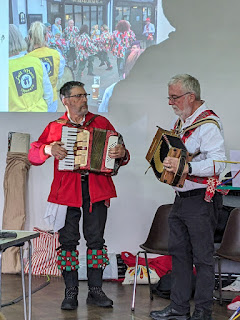The Parks Department began in 1891 and was formed by the Pettigrew family. Pettigrew was a pioneer gardener. Originally there were park keepers for every Cardiff park, and the last one of these retired in 2022. In 1979 the park keepers’ responsibilities became part of the local authority, and then they were renamed ‘rangers’ in the 1990s. There are three types of ranger: urban, woodland and community.
Urban rangers cover a wider range of work than just gardening – such as dealing with fly tipping and rough sleepers. Woodland rangers are tree surgeons and highly trained. They are also responsible for the Radyr hydroelectric dam, and for Flat Holme and Steep Holme.
There are nine Community Rangers who work a seven-day week on rotation in all weather. Rhodri said that he finds it interesting and challenging work. They have won the Green Flag award for their guided walks, open days, work with kids, and school trips. They work with all ages – from little reception children to university students. Community rangers also work with volunteers and ‘friends’ groups. Some ‘friends’ groups have existed since the 1990s. Last year there were 4,282 volunteer hours of work completed. They also have working partnership with other organisations, such as Coed Caerdydd, The Local Nature Partnership, Cardiff Rivers Group, Cardiff Conservation Volunteers, charities, and corporate groups. Rangers also help with wildlife monitoring, such as surveys and recordings.
Rhodri has been a community Ranger since September and works a rota of eight days on, two days off; seven days on, four days off. He then gave us a glimpse of what eight days of work might look like:
1. wetland work in the morning and in the afternoon admin, such as answering emails.
2. a Halloween craft event for children, and looking at folklore and mythology.
3. a site meeting with management about the eviction of an unlawful occupation of council land in the morning, and in the afternoon grass cutting.
4. working with volunteers at Coed y Felin, Lisvane, putting up fencing to prevent erosion by people who don't keep to the paths.
5. sharpening tools, and an evening bat walk which 74 people attended in Hendre Park, St Mellons .
6. assisting storm response tree gangs dealing with fallen or dangerous trees, such as an old tree that had come down across the path at Forest Farm.
7. Meadow management and green hay trials. This is taking cuttings from one area with a lot of wildflowers to other areas with fewer wildflowers, such as taking mowings from Forest Farm and Grange Moore Park to other areas. The grounds maintenance team do most of the mowing.
8. working with Friends of Saint Mary's Gardens in Whitchurch. This friends group was started by WI members for the community and wildlife. It's won awards. This year it was very close to getting a level five, and that's what we're going for next year.













































